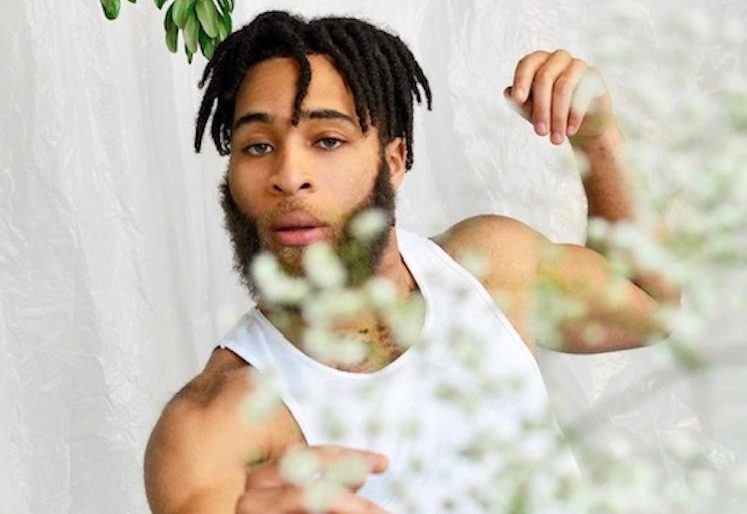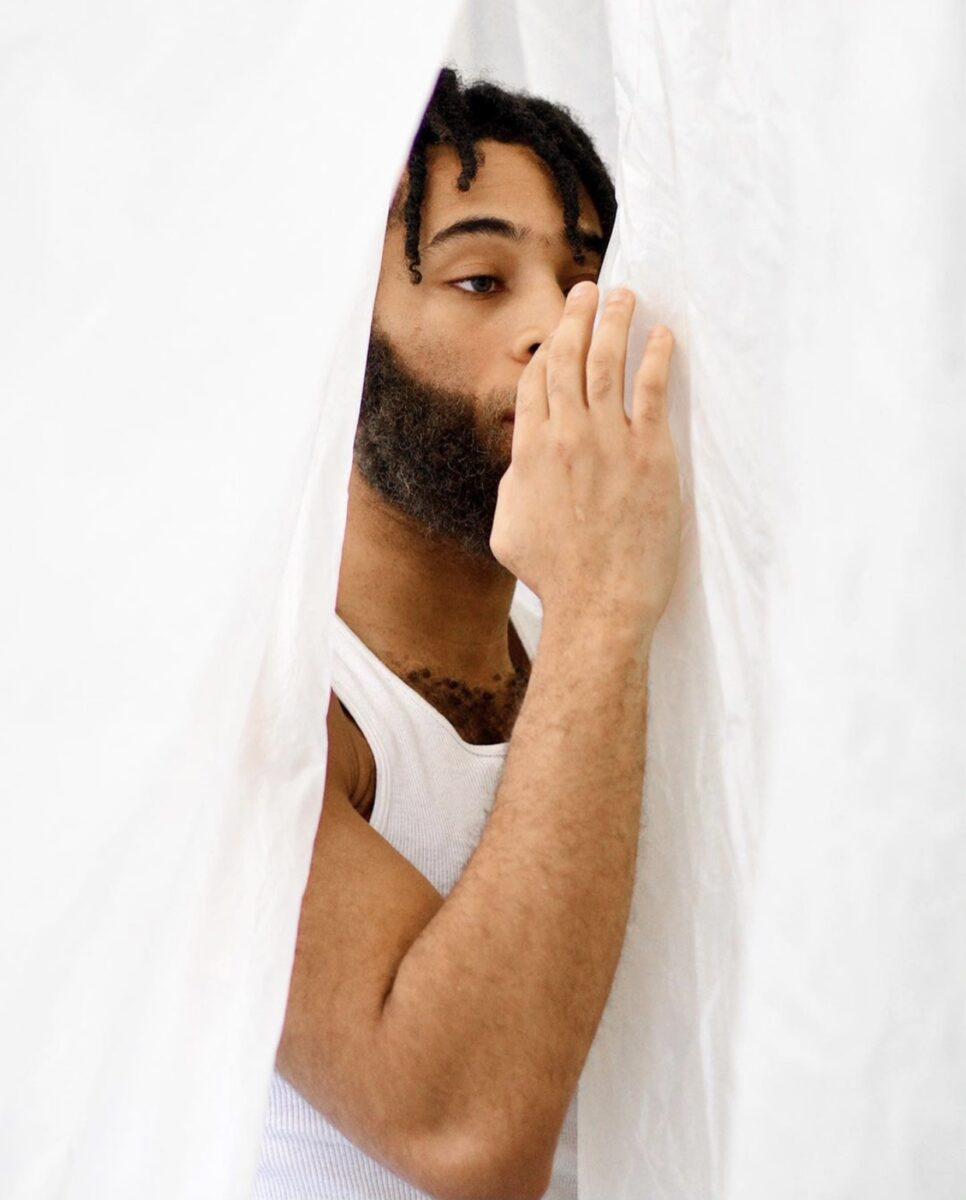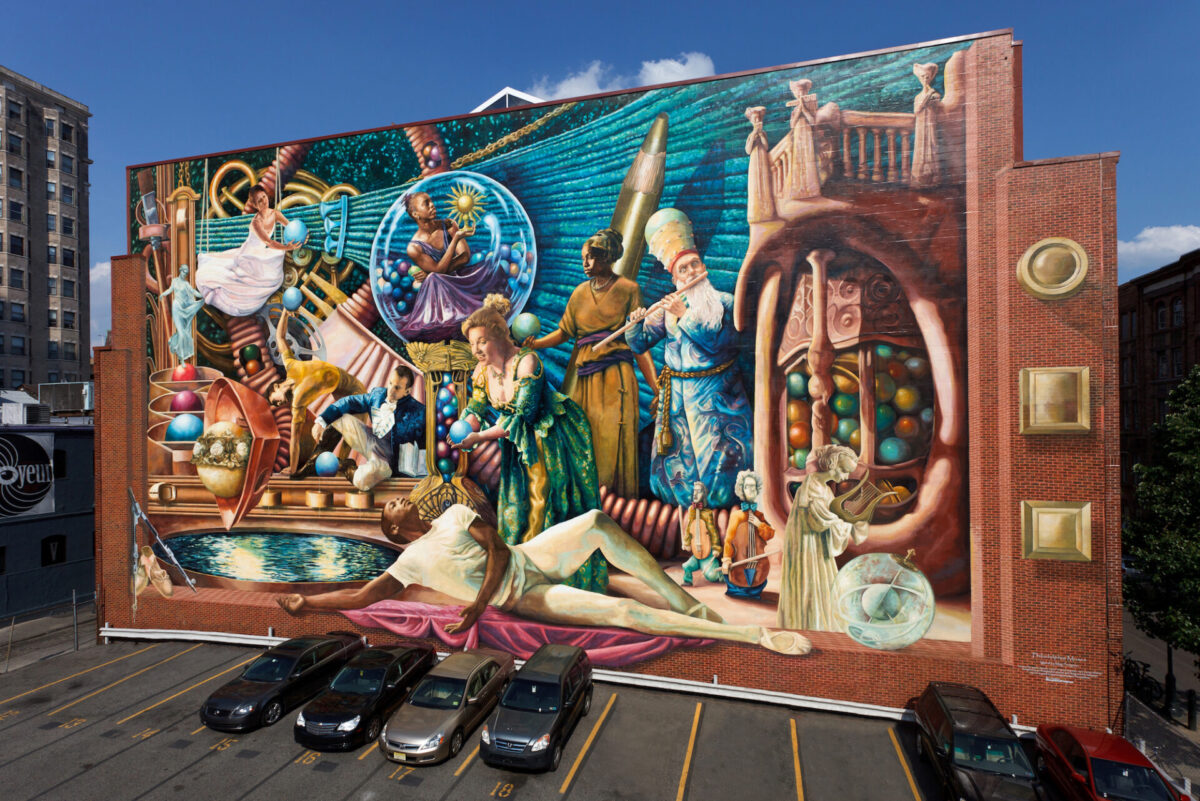
Kingsley Ibeneche | photo by Marcus Branch | courtesy of the artist
Music+Art: Kingsley Ibeneche on Meg Saligman’s Philadelphia Muses
Philadelphia is a music-rich city and a trove of visual art, from graffiti pier to the Clothespin to our massive collection of Impressionists in the Philadelphia Museum of Art and at the Barnes Foundation. How do the music and art worlds speak to each other? In this series, Music+Art, we chat with hometown musicians about their favorite art works in Philadelphia.
Philadelphia Muses is a 6000-square foot mural at 13th and Locust Streets. Pulsing with creative force, this arresting mural alludes to the classical muses to celebrate the spirit of Philadelphia’s artists in disciplines as diverse as architecture, painting, ballet, music, and theater.
This emblem of genre-bending was one of the first things that Kingsley Ibeneche saw when he moved here to study dance, and its timbre has been humming in him since. In the past eleven years, Ibeneche has gone on to integrate soul music, movement, and drama, and to collaborate with filmmakers and photographers to visually accompany to his work. In this interview, we catch up with him from his producer Lee Clark’s house, where the two are putting finishing touches on Ibeneche’s first album, expected in late 2021. We talk about his first encounter with this influential mural, and discuss how visual art informs his practice at large.

The Key: Your work is interdisciplinary by nature, integrating mostly dance and music, and sometimes theater. How is visual art a part of your practice?
Kingsley Ibeneche: I get a lot of inspiration for movement and sound from still images. My best friend Marcus Branch is a photographer. I spent a lot of time as an undergrad shadowing him, and got to see how he preserved life with his lens. It inspired me to do the same. I’m no photographer, but I can create moments that are everlasting. Before I create performances, rather than watching videos or listening to music, I go to still images. This helps me dwindle down my huge ideas into moments. These moments become the piece, as if we were moving with the click of a camera. I try to visualize everything I do like that. I never want to waste a moment.
TK: How do the visual art and music scenes collide in your corner of Philly music?
KI: I think of the photographers and filmmakers who capture my work: they’re just as important as the performers. When I’m doing a show, I love when a photographer’s around, because we get to dance together. You can tell when someone has movement in them, and a good filmmaker understands movement.
TK: What is your favorite artwork in Philadelphia?
KI: Philadelphia Muses by Meg Saligman. In 2009, my first year at UArts, I had a modern dance teacher named Kim Bears. This woman had my mother’s eyes, and her heart. I didn’t think of her as an especially great figure—I was seventeen, I didn’t know anything—but I sensed even in the first week that she was important. That same week, I took a walking tour of campus. We came upon a mural, and who did I see in the middle of the piece but my teacher, Miss Kim, holding a sun. Well thank God it was summer, because I must have stood there forty five to an hour, thinking, “Is this what happens when you become a force in art? You get immortalized like this?” I didn’t look at any aspect of the painting other than her because I was so captured by it. Then my eyes widened, and I saw everything that surrounds her: images representing all mediums of creation. It’s so full of color and characters, just like the street where it’s located. This moment will always be imprinted in my mind. I stood there so long I didn’t take a picture.

TK: They say the average time a person spends looking at a work of art is 17 seconds. That you stood so long says a lot about the work, and about you.
KI: I think my talent is being inspired. My talent is to admire. And this, this was something to look up to. It was shoes to fill. It was scary and beautiful and breathtaking and entertaining. It was an honor to see my teacher up there on the wall, and I thought, “One day, maybe, I can do this.”
TK: Has Philadelphia Muses influenced the project you’re working on now?
KI: When you look at this painting, you see that the artist is diligent, consistent, and serious about what they do. This inspires how I work. I want to be consistent, and be diligent, and most of all, be true.
TK: Tell me about your upcoming record. Are there visual elements to it?
KI: It’s called Udo, for the village in Nigeria where my father’s from. There’s a song on the album called “So Kind,” which has a video coming out soon. The song, and the album, are about relinquishing the image people see when they look at me and discovering what I actually am. People see me as so kind, but there’s a rawness to me that I want to be able to express. I want to imitate my elders. They say what they want; they don’t fear judgement. I’m trying to get to that point early in my life. Through the music video I surround myself with “the village”: the people and spaces that have nurtured me and seen who I am and who I’m becoming. My team and I show this through earth tone wardrobe, green fields, Nigerian symbolism, dance, and filmed portraits. This video is a visual representation of a rebirth. A coming to terms with all of our souls, with all the things that guide us. Relinquishing attachment to all lives, and focusing on unity of one infinite spirit.